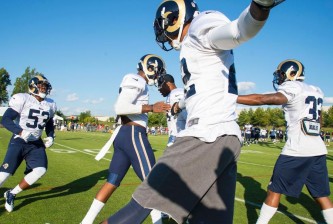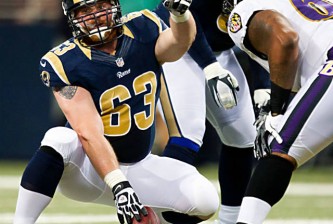Recapping “To Go or Not to Go, Part 1:” Facing fourth-and-goal from the two, still down 21-3 late in the third period, Coach Spagnuolo was likely looking at the past events in the game — a failed fourth-and-1 in the first half, and three stuffed runs by Jackson on the current drive — and not at the desperate situation the team was facing. Ultimately, he made the (wrong) decision to kick the field goal.
After teeing off against the Matt Leinert Cardinals (outscored 24-0 so far this season) and getting an electric punt return from Danny Amendola to the Arizona 44, Spagnuolo put past performance on the shelf and focused immediately on the here-and-now. His Rams were down 15 with time ticking off — 12 minutes left, maybe four or five total possessions for both teams left in the game. He needed scores, and he needed them now.
So, facing a fourth-and-seven on the Arizona 41, he went for it, and made it on a fortuitous defensive holding penalty.
Facing a fourth-and-one from the 25, he sent Steven Jackson in to bull forward for the conversion.
Facing a fourth-and-eleven on the 26, he went for it a third time, dialing up a gutsy all-or-nothing pass to Danny Amendola that took us to the one.
For those decisions, we applaud Spagnuolo. But honestly, he really didn’t have much of a choice, if the Rams were going to stay in this game. The critical go/no-go decision, the trickier one by far, came after the Rams scored on a one-yard reach by Jackson to come within nine points.
Go or Don’t Go: Should they have gone for two to make it a seven-point game?
At the time, as Spags sent in the kicking unit, here was my reaction:
And I was far from alone on the topic. But experts have weighed in, and the correct answer is NO, kick the PAT. Or, perhaps it is YES, Go for two! Two warring camps of analysis face off after the break:
Facing this two-point conversion decision, or more commonly, when defending a decision after the game, head coaches talk about “The Chart.” Some claim to carry a laminated sheet (stuffed attractively into their waistbands, no doubt) with tables telling them whether to go for the PAT or the deuce depending on the score of the game.
The trouble is, there are multiple versions of The Chart out there. Google’s top-ranked version, charted by Norm Hitzges, says “Kick the PAT.”
However, this doesn’t account for the type of game being played. With Leinert in at QB, the Cardinals were suddenly mudbogged, making this game count as a “Slug” (rather than a “Frenzy”) in the Loser of the Week’s revised two-point conversion chart. That chart says, helpfully, “???“
Getting deeper into the math, William Krasker of FootballCommentary.com built a Dynamic Programming Model to make this decision for you. It assumes that a team’s baseline chances of making the two stand at about 40%. And his version of The Chart essentially says that, down by nine with seven minutes to play, “Go with your gut.”
But just looking at time remaining doesn’t fully account for football behavior. Against a good offense, seven minutes left might mean one more possession, max, for your team. But with all your timeouts, facing the hobbled Matt Leinert Cardinals, you could squeeze two or more in.
Harold Sackrowitz, Rutgers professor of applied mathematics, looked deeper into this problem. He took possessions remaining in the game into account, and published his results in “American Football Coach.” (A subsequent mention in Sports Illustrated brought his findings quick fame.) His chart (and underlying analytical paper) says with no equivocation, “Go for two!”
So, there’s your answer: We were right! (Maybe.)
However, these mathy guys know the real-world risks of going for it in these desperate situations. Krasker is quoted in Coaching Management:
Sackrowitz weighs in as well:
Another quote from a high school football coach, later in this same article, gives us the final word:






















